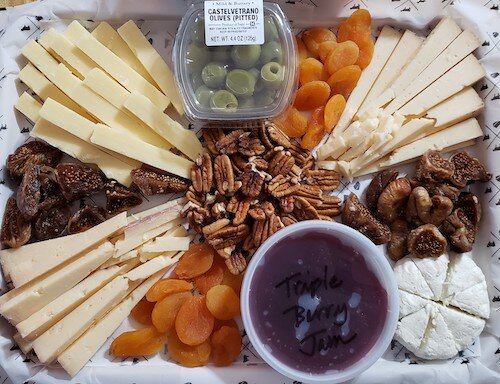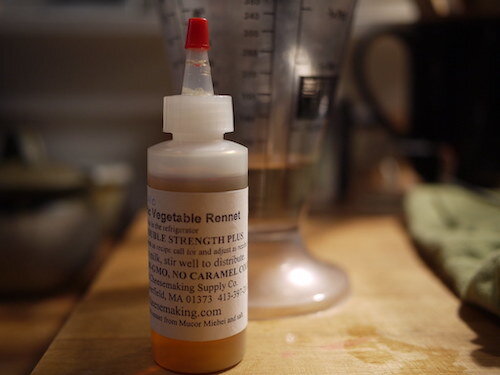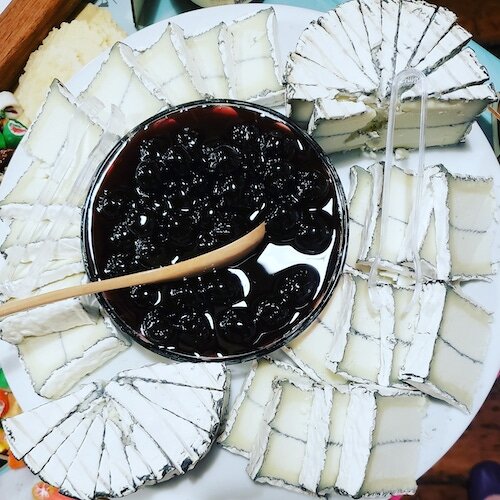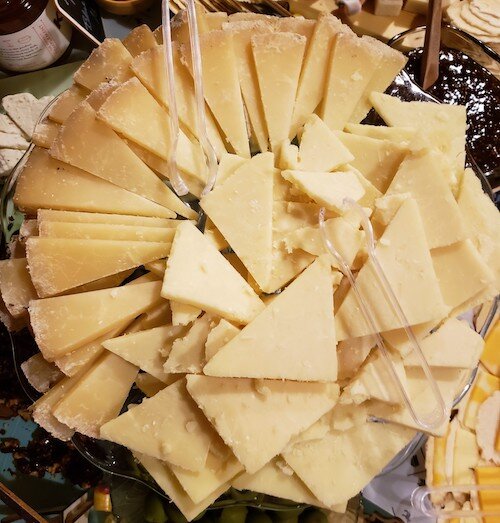Do You Know Which Cheeses Are Vegetarian Friendly?
Editor’s note: Marcella Wright is a cheesemonger, educator, and founder of the Facebook Cheese Study Group. Because she has developed a very comprehensive list of vegetarian suitable cheese, we asked her to explain this category in depth.
Vegetarian suitable cheese platter with BellaVitano, Purple Haze, and Cabot Cheddar
In the cheese world, there is still debate as to whether cheese made from mammal’s milk is truly vegetarian-suitable, meanwhile retailers understand that there is a growing market for cheeses made from dairy milk, but with non-animal based rennet. But first, it’s worth reviewing why rennet is so important in making cheese. Simply put rennet is a key component of cheesemaking. Basically, cheese is made by separating the solids (fat, protein, and minerals) from the liquid (whey). Rennet is the necessary agent that triggers the coagulation of milk, separating the curd from the whey.
The History of Rennet Usage in Cheese
It is generally accepted that the first cheeses were made by using animal rennet (extracted mucosa) from the fourth stomach chamber (the abomasum) of an unweaned lamb. One legend about the first creation of cheese alleges a desert nomad stored milk in the stomach of a dead sheep. The stomach was leak-proof and a perfect storage container. During transportation, the milk was agitated, resulting in curdled milk when the shepherd cut the stomach open. The first cheese was born. There are references to cheese as early as 8000 BCE.
Today, most animal rennet is calf’s rennet which is a by-product of butchering in veal production.
In 1987, John Robbins, son of Irv Robbins of Baskin-Robbins, published Diet for a New America. In his book he describes the cruel processes used to produce veal. I read that book and stopped eating veal. (While in France in 2019, I did have veal once, but found myself remembering the Robbins book and could not enjoy it.)
Types of Rennet
Vegetable rennet
In the late 20th-century veal demand fell causing production to decrease. The cost of veal rennet rose drastically. In turn, the cost of making animal rennet cheese rose. Cheesemakers sought an alternative. Where there is demand, there will be invention. Scientists went to work and non-animal rennets were created. Pfizer created the first FPC (fermentation-produced chymosin) and it has been on the market since 1990; 3 years after the publication of Robbins’ book. Microbial is the most popular of these rennets, created using molds and other microbes. Lab-created chymosin, which mimics animal rennet, is also popular. Lab-produced rennet is cheaper than animal rennet making those cheeses less expensive to produce and less expensive for the consumer.
Producers using animal rennet claim it is more stable and produces more consistent cheese than lab-produced rennets. This may have been true with the first non-animal rennets, but today, microbial rennet and lab-created chymosin have become more stable and more attractive to cheesemakers.
The Use of Alternative Rennets
Humboldt Fog vegetarian cheese. Photo courtesy of Marcella Wright.
Lab produced alternative rennets also created a new market which satisfied vegetarians desire to eat cheese. Dedicated vegetarians eat no food produced from the death of an animal. Eggs and dairy products come from live animals and are acceptable to many vegetarians. Vegetarian-suitable cheeses are not eaten by vegans whose philosophy is to eat nothing that comes from anything that once had a face. Vegan cheeses use no dairy milk whatsoever.
Many traditional European cheeses use animal rennet to coagulate milk in the cheesemaking process. The use of animal rennet is part of the PDO designations to protect many EU cheeses. However, most cheesemakers in England and the United States prefer microbial rennet and chymosin.
Some cheesemakers also use “true” plant-based enzymes as a coagulating agent, such as thistle, which has been used for a very long time. Lemon juice, vinegar, and citric acid can also be used to coagulate milk. Other cheeses can be naturally coagulated with time, known as lactic-set cheeses. These cheeses are also suitable for vegetarians.
Finding Vegetarian-Friendly Cheese
Beecher’s cheese photo courtesy of Marcella Wright
When I began my career as a Cheese Steward for Kroger, not many customers asked about vegetarian-suitable cheeses. However, those requests increased, and I began researching to find cheeses vegetarians would and could eat. Because of the increasing demand, I created a list of vegetarian-suitable cheeses for my website in 2009. It contained approximately 200 cheeses.
Recently, in reviewing statistics for my website, I discovered the second-most viewed page was that list. I spent several weeks updating the list and including the producer and country of origin. The list now has more than 1000 cheeses suitable for vegetarians and anyone interested in more environmentally-friendly cheeses. You can view my updated database here.




